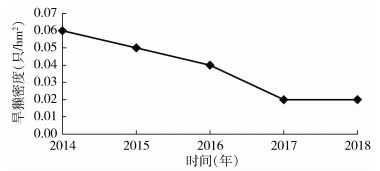
扩展功能
文章信息
- 麻占军, 扎西, 陈自强, 巴桑泽仁
- MA Zhan-jun, ZHA Xi, CHEN Zi-qiang, BASANG Ze-ren
- 西藏自治区2014-2018年鼠疫监测结果分析
- An analysis of surveillance results of plague in Tibet autonomous region, China, 2014-2018
- 中国媒介生物学及控制杂志, 2020, 31(3): 345-349
- Chin J Vector Biol & Control, 2020, 31(3): 345-349
- 10.11853/j.issn.1003.8280.2020.03.020
-
文章历史
- 收稿日期: 2019-12-30
我国存在着世界上面积最大、最为复杂多样的鼠疫自然疫源地, 其中, 青藏高原喜马拉雅旱獭(Marmota himalayana)鼠疫自然疫源地是人和动物鼠疫发生最多的疫源地之一[1]。西藏自治区(西藏)是青藏高原喜马拉雅旱獭鼠疫自然疫源地的重要组成部分[2], 自1966年证实鼠疫流行以来, 50余年间鼠疫疫情始终处于活跃流行态势, 动物鼠疫连年不断, 人间鼠疫时有发生[3], 新的疫源县不断被发现, 截至2018年, 已判定疫源县52个(其中细菌学阳性县46个, 血清学阳性县6个), 疫源地总面积达80余万km2[4], 给人民生命和财产安全带来极大威胁。本研究分析西藏2014-2018年的鼠疫监测数据, 分析疫情流行形势, 为今后鼠疫防治与监测工作提供科学依据。
1 材料与方法 1.1 资料来源收集整理2014-2018年拉萨、日喀则、山南、林芝、昌都、那曲、阿里7个市(地区)所辖52个鼠疫自然疫源县的监测资料和数据。其中拉萨市堆龙德庆区、当雄县、城关区, 那曲市色尼区、安多县、比如县, 山南市隆子县、错那县和加查县为9个国家级固定监测点。日喀则市桑珠孜区、仲巴县, 林芝市朗县、米林县, 昌都市卡若区、丁青县, 阿里地区噶尔县和札达县为8个省级固定监测点。其余29个鼠疫细菌学阳性县和6个血清学阳性县设为流动监测点。
1.2 监测内容与方法监测内容包括人间鼠疫病例监测和动物间鼠疫监测, 具体监测方法按照《西藏自治区鼠疫监测方案》《西藏自治区鼠疫监测方案实施细则》和《全国病媒生物监测实施方案》[5]进行。
1.2.1 人间鼠疫病例监测根据西藏鼠疫监测方案, 对人间鼠疫进行监控, 诊断标准按照中华人民共和国卫生行业标准《鼠疫诊断标准》(WS 279-2008)执行。
1.2.2 动物间鼠疫监测包括旱獭密度、小型鼠、媒介蚤、血清学和病原学监测。
1.2.2.1 旱獭密度监测采用路线法, 以步行、骑马、汽车直线或曲线向前行进, 以起点开始计时, 同时观察旱獭数量。视野宽度一般以每侧50~100 m为宜, 路线长度以步行3 km/h, 骑马5 km/h的速度乘以行走时间来计算, 汽车则按里程表计算。以路线长度乘以视野宽度求出调查面积, 最后换算出旱獭密度。

|
每月选择2~3种生境, 以花生米或白面油饼为诱饵, 采用5 m夹线法进行监测。

|
鼠体蚤调查采用乙醚麻醉、单只袋装方法梳检鼠体; 洞干蚤调查采用胶管缠棉反复探洞3次。

|
采集犬、羊、旱獭等动物血清, 对所采集动物血清采用间接血凝试验方法进行检验。
1.2.2.5 病原学检测广泛搜集一切可检材料, 以病死旱獭为主, 对所取病死动物心、肝、脾、肺、腺体、骨髓等材料, 进行组织培养。
1.3 统计学分析应用Excel 2003软件建立数据库, SPSS 17.0软件用于统计分析。小型鼠和媒介蚤用构成比进行描述, 不同市(地区)间的鼠疫菌阳性检出率差异采用χ2检验, 鼠疫菌检出数与旱獭密度的关系采用回归与相关分析。P < 0.05为差异有统计学意义。
2 结果 2.1 人间鼠疫2014-2018年西藏未发生人间鼠疫。
2.2 动物间鼠疫 2.2.1 旱獭密度2014-2018年间, 全区共监测旱獭面积272 279 hm2, 发现旱獭9 000只, 平均旱獭密度为0.03只/hm2。从时间分布来看, 2014年密度最高, 为0.06只/hm2, 之后呈逐年下降趋势, 见图 1。

|
| 图 1 2014-2018年西藏自治区旱獭密度年际变化 Figure 1 Interannual variation in marmot density in Tibet autonomous region, 2014-2018 |
| |
2014-2018年, 全区共布放鼠夹102 497夹次, 捕获小型鼠1 023只, 捕获率为1.00%, 黑唇鼠兔(Ochtona curzoniae)为优势种, 共捕获766只, 占74.88%;藏仓鼠(Cricetulus kamensis)、白尾松田鼠(Phaiomys leucurus)、大耳鼠兔(O. daurica)和未鉴定鼠类构成见表 1。

|
全区共梳检旱獭176只, 染蚤獭49只, 获蚤91匹, 旱獭体染蚤率为27.84%, 蚤指数为0.52。斧形盖蚤(Callopsylla dolabris)和谢氏山蚤(Oropsylla silantiewi)分别占总蚤数的45.05%和43.96%, 腹窦纤蚤(Rhadinopsylla liventricosa)及未鉴定蚤类构成见表 2。共梳检小型鼠606只, 染蚤鼠11只, 获蚤15匹, 染蚤率为1.82%, 蚤指数为0.03, 所获蚤类均未鉴定。

|
共探旱獭洞19 748个, 染蚤洞153个, 获蚤194匹, 洞干染蚤率为0.77%, 蚤指数为0.01。所获蚤类中斧形盖蚤112匹, 占总蚤数的57.73%;谢氏山蚤、腹窦纤蚤和未鉴定蚤类构成见表 3。

|
检验各类动物材料2 526份, 分离出鼠疫耶尔森菌(鼠疫菌)106株, 阳性率为4.20%。鼠疫菌分布于除昌都市以外的其他6市(地区)所属的21县(区)。各市(地区)间鼠疫菌阳性率差异有统计学意义(χ2=293.646, P < 0.001), 其中阿里地区阳性率最高, 达到37.14%, 其次为拉萨市, 为10.79%, 昌都市最低, 未检出鼠疫菌, 见表 4。从年际分布来看, 2015年鼠疫菌检出数最多为30株, 阳性检出率为12.24%;2018年最少为10株, 阳性检出率为1.95%, 2015年后, 鼠疫菌检出数和阳性检出率均呈现逐年下降的趋势, 见图 2。

|

|
| 图 2 2014-2018年西藏自治区鼠疫病原学检测时间分布 Figure 2 Distribution of pathogenic surveillance time of plague in Tibet autonomous region, 2014-2018 |
| |
全区采集检验旱獭、野犬(Canis canis)、家犬(C. lupus familiari)、藏系绵羊(Ovis gentilis)、山羊(Capra Hircus)及其他动物血清29 668份, 阳性50份, 阳性率为0.17%, 其中野犬血清阳性39份, 藏系绵羊血清阳性为11份, 其余动物血清均为阴性。阳性野犬血清分布于拉萨、日喀则、林芝、阿里4个市(地区)所辖的13个县(区); 阳性藏系绵羊血清分布于拉萨市堆龙德庆和曲水2县。7市(地区)中拉萨市阳性血清最多, 为27份, 见表 5。

|
以鼠疫菌检出数量为应变量y, 旱獭密度为自变量x, 建立回归方程为y=488.909x+3.110, F=10.751, P=0.046, 随着旱獭密度的变化, 鼠疫菌检出数会随之发生改变, 且存在正相关(r=0.884, P=0.023)。
3 讨论 3.1 疫情流行概况西藏自1966年首次证实人间鼠疫的发生和流行以来, 截至2010年, 共发生人间鼠疫22起, 发病120例, 死亡75例, 平均死亡率为62.50%[6], 成为全国人间鼠疫病死率最高的地区。随着鼠疫监测系统的不断完善, 以及各项鼠疫防控措施的有效落实, 2011年后已连续8年未发生人间鼠疫, 人间鼠疫呈明显下降趋势[4]。50余年间, 除个别年度未从动物体内分离出鼠疫菌外, 其余年度均有动物鼠疫发生[7]。2014-2018年鼠疫菌检出数呈逐年减少趋势, 各市(地区)间鼠疫菌阳性检出率差异有统计学意义。阳性血清主要来自野犬和藏系绵羊, 西藏曾3次发生因剥食病死藏系绵羊而引起的人间鼠疫, 藏系绵羊在西藏鼠疫流行病学中仅次于旱獭而居第2位[8]。
3.2 鼠疫监测现状2014-2018年主要宿主动物(旱獭)密度介于0.02~0.06只/hm2之间, 与2001-2010年相比明显降低[9], 并呈现逐年下降趋势, 与大力开展保护性灭獭工作有关[10]。西藏小型鼠以黑唇鼠兔为优势种, 媒介蚤以斧形盖蚤和谢氏山蚤为优势种群[11], 小型鼠和媒介昆虫监测工作存在监测数据过少、小型鼠捕获率偏低和未鉴定种类较多的现象, 对鼠疫疫情无法起到预测预警作用, 这与西藏缺乏小型鼠和媒介生物监测专业人员, 监测技术不够完善有一定关系。针对此种情况, 西藏自治区卫生健康委员会应急办和西藏自治区疾病预防控制中心于2016年底联合下发了《西藏自治区鼠疫预防控制和监测目标管理考核办法及其实施细则》的文件, 要求各疫源县严格按照《西藏自治区鼠疫监测方案》开展鼠疫监测工作, 并实行年终考核, 同时加大专业人员监测技能培训力度, 2017和2018年监测数据明显增多。
3.3 旱獭密度与鼠疫菌检出数的关系西藏近5年旱獭密度与鼠疫菌检出数之间存在正相关关系。有研究表明, 西藏旱獭密度与动物间鼠疫不存在线性相关关系[12], 这可能是由于西藏鼠疫自然疫源地面积大, 旱獭分布广泛, 加之从事鼠疫防治和监测工作的人数少, 物力、财力等监测所需的资源缺乏, 造成监测和检索不能覆盖到鼠疫监测区域, 同时也与过去相当长时期领导对这方面工作重视程度不够有一定关系。
3.4 防控形势及建议西藏鼠疫宿主动物分布广泛, 动物间鼠疫持续流行, 虽然人和动物间鼠疫均呈下降趋势, 但随着外来人员的增多, 交通条件的改善, 动物间鼠疫由偏远地区向城镇和交通沿线逼近的趋势[13], 导致发生人间鼠疫甚至疫情远距离传播的风险也在逐年增大[14-16]。藏系绵羊是西藏的重要家畜, 每年均有相当数量的羊肉和皮毛运往拉萨市并转运至全国各地, 给鼠疫防治工作带来极大难度, 藏系绵羊引起人间鼠疫的流行病学意义不容忽视[17]。西藏鼠疫防治形势依然严峻, 需充分认识鼠疫的危害性, 加强鼠疫防治工作的组织领导, 提高鼠疫监测能力, 并长期坚持鼠疫监测、宣传教育、人员培训、保护性灭獭和疫情应急处置等综合性鼠疫防控措施, 尤其需加大拉萨市、阿里地区、日喀则市等动物间鼠疫活跃的重点城市的防控力度, 不断完善鼠疫监测系统, 才能使鼠疫疫情得到有效控制, 为各族人民群众的身体健康和生命安全提供保障。
| [1] |
王梅.喜马拉雅旱獭疫源地鼠疫菌特征研究[D].北京: 中国疾病预防控制中心, 2011. Wang M. The features study about plague in natural foci of Marmota himalayana[D]. Beijing: Chinese Center for Disease Control and Prevention, 2011. |
| [2] |
西绕若登, 李景中, 洛桑群增, 等. 西藏鼠疫流行现状与青藏铁路沿线鼠疫预防控制对策[J]. 中国地方病防治杂志, 2008, 23(3): 198-200. Xi RRD, Li JZ, Luo SQZ, et al. The current situation of plague epidemic in Tibet and the control strategy of plague along the Qinghai Tibet Railway[J]. Chin J Control Endem Dis, 2008, 23(3): 198-200. DOI:10.3969/j.issn.1001-1889.2008.03.015 |
| [3] |
蒋志勇, 刘刚. 西藏鼠疫防治监测现状及对策[J]. 西藏医药, 2007, 28(4): 50-51. Jiang ZY, Liu G. Current situation and countermeasures of plague control and surveillance in Tibet[J]. Tibetan J Med, 2007, 28(4): 50-51. |
| [4] |
麻占军, 李景中, 扎西. 西藏自治区鼠疫流行形势分析[J]. 医学动物防制, 2019, 35(6): 556-558. Ma ZJ, Li JZ, Zha X. Analysis of the epidemic situation of plague in Tibet autonomous region[J]. J Med Pest Control, 2019, 35(6): 556-558. DOI:10.7629/yxdwfz201906013 |
| [5] |
中国疾病预防控制中心.全国病媒生物监测实施方案[Z].北京: 中国疾病预防控制中心, 2016. Chinese Center for Disease Control and Prevention. National vector surveillance implementation plan[Z]. Beijing: Chinese Center for Disease Control and Prevention, 2016. |
| [6] |
麻占军, 蒋志勇. 西藏自治区1966-2012年人间鼠疫流行病学分析[J]. 中国地方病防治杂志, 2013, 28(2): 119-122. Ma ZJ, Jiang ZY. Epidemiological analysis of human plague in Tibet autonomous region from 1966 to 2012[J]. Chin J Control Endem Dis, 2013, 28(2): 119-122. |
| [7] |
扎西. 西藏鼠疫防治研究50年回顾[J]. 西藏医药, 2018, 39(6): 3-5. Zha X. Review of 50 years' research on plague control in Tibet[J]. Tibetan Med, 2018, 39(6): 3-5. |
| [8] |
骆孝志. 青藏高原喜马拉雅旱獭鼠疫流行特征研究概况[J]. 中国媒介生物学及控制杂志, 2010, 21(4): 394-398. Luo XZ. An overview of the epidemiological characteristics of Marmota himalayana plague on Qinghai-Tibet plateau[J]. Chin J Vector Biol Control, 2010, 21(4): 394-398. |
| [9] |
李景中, 西绕若登, 蒋志勇, 等. 西藏自治区2001-2010年鼠疫监测结果[J]. 中国地方病防治杂志, 2013, 28(1): 65-66. Li JZ, Xi RRD, Jiang ZY, et al. Plague surveillance results in Tibet autonomous region from 2001 to 2010[J]. Chin J Control Endem Dis, 2013, 28(1): 65-66. |
| [10] |
扎西, 巴桑次仁, 索朗德吉, 等. 2017年西藏自治区鼠疫监测与防治工作调查[J]. 西藏医药, 2018, 39(5): 4-5. Zha X, Ba SCR, Suo LDJ, et al. Investigation on plague monitoring and control in Tibet autonomous region in 2017[J]. Tibetan J Med, 2018, 39(5): 4-5. |
| [11] |
卢占胜, 曾诚, 郭文涛, 等. 玉树地区鼠疫虫媒种群构成监测结果分析[J]. 现代预防医学, 2015, 42(7): 1310-1311, 1318. Lu ZS, Zeng C, Guo WT, et al. Analysis of monitoring results of plague insect vectors composition, Yushu area[J]. Mod Prev Med, 2015, 42(7): 1310-1311, 1318. |
| [12] |
刘刚. 2005-2010年西藏自治区鼠疫监测结果分析[D].长春: 吉林大学, 2011. Liu G. Analysis of the plague surveillance in Tibet from 2005 to 2010[J]. Changchun: Jilin University, 2011. |
| [13] |
郭红梅.我国青藏铁路沿线鼠疫的危险性及控制策略的探讨[C]//青藏铁路运营十周年学术研讨会卫生系统论文集, 拉萨, 2016.拉萨: 中国铁道学会, 青海省科学技术协会, 西藏自治区科学技术协会, 2016: 150-153. Guo HM. Discussion on the risk and control strategy of plague along the Qinghai Tibet Railway in China[C]//Proceedings of the 10th Anniversary of Qinghai Tibet Railway Operation Symposium on Health System, Lhasa, 2016. Lhasa: China Railway Society, Qinghai Science and Technology Association, Association of Science and Technology of Tibet Autonomous Region, 2016: 150-153. |
| [14] |
边境, 席进孝, 王玉. 甘肃省鼠疫疫情及其影响因素分析[J]. 卫生职业教育, 2010, 28(11): 115-116. Bian J, Xi JX, Wang Y. Analysis of plague epidemic situation and its influencing factors in Gansu province[J]. Health Vocat Educ, 2010, 28(11): 115-116. DOI:10.3969/j.issn.1671-1246.2010.11.069 |
| [15] |
杨建国, 游培松, 李胜, 等. 青海省近年来鼠疫防控形势分析[J]. 医学动物防制, 2018, 34(3): 280-282. Yang JG, You PS, Li S, et al. The prevention and control situation analysis of plague in recent years in Qinghai province[J]. J Med Pest Control, 2018, 34(3): 280-282. DOI:10.7629/yxdwfz201803022 |
| [16] |
郑谊, 张爱萍, 李千, 等. 青海省人间鼠疫流行病学分析[J]. 首都公共卫生, 2017, 11(2): 50-52. Zheng Y, Zhang AP, Li Q, et al. Epidemiological characteristics of human plague in Qinghai province[J]. Cap J Public Health, 2017, 11(2): 50-52. DOI:10.16760/j.cnki.sdggws.2017.02.002 |
| [17] |
何健, 熊浩明, 祁美英, 等. 青海省藏系绵羊引起人间鼠疫的流行病学特征分析[J]. 中华地方病学杂志, 2016, 35(5): 354-356. He J, Xiong HM, Qi MY, et al. Epidemic analysis of human plague caused by Tibetan sheep in Qinghai province[J]. Chin J Endemiol, 2016, 35(5): 354-356. DOI:10.3760/cma.j.issn.2095-4255.2016.05.010 |
 2020, Vol. 31
2020, Vol. 31



